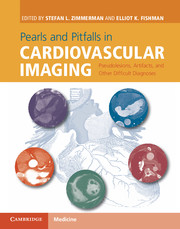 Pearls and Pitfalls in Cardiovascular Imaging
Pearls and Pitfalls in Cardiovascular Imaging from Section 1 - Cardiac pseudotumors and other challenging diagnoses
Published online by Cambridge University Press: 05 June 2015
Imaging description
Lipomatous hypertrophy of the interatrial septum (LHIS) is a benign process of the heart characterized by fatty infiltration of the interatrial septum. The diagnosis is made when fat in the interatrial septum measures greater than 20 mm in thickness and it is usually an incidental finding at cardiac imaging.
At echocardiography, LHIS is recognized by echogenic thickening of the interatrial septum. On multiple detector computed tomography (MDCT) (with or without contrast) LHIS is a low-attenuation, < 0 Hounsfield units, bilobed mass with smooth margins that spares the fossa ovalis. It is this sparing of the fossa ovalis which gives this entity its characteristic bilobed or dumbbell-shaped morphology (Figure 2.1). Often, there is cranial extension to the level of the cavoatrial junction and fat may surround the distal superior vena cava (Figure 2.2).
On MRI the morphology of LHIS is similar to MDCT. The LHIS demonstrates hyperintensity on T1-weighted imaging with homogenous signal drop out on a fat-suppressed T1 sequence characteristic of macroscopic fat (Figure 2.2). On post-gadolinium sequences no enhancement is seen.
FDG uptake within the atrial septum at positron emission tomography (PET) examinations may be seen, and is attributed to the variable presence of brown fat within LHIS (Figure 2.3). It is important to note that the benign FDG uptake in LHIS must not be mistaken for a malignant process such adenopathy or metastatic tumor. Fusion PET-CT will help localize radiotracer uptake to the atrial septum and differentiate it from surrounding structures such as the right hilum, pleura or mediastinum. In difficult cases, it may be necessary to correlate PET-CT findings with either MRI or MDCT in order to prevent inappropriate staging of the patient.
Importance
The condition of LHIS is a benign incidental finding and typically does not cause any symptoms. Since it may demonstrate increased FDG uptake on PET/CT, it must not be confused with a malignant process, leading to misdiagnosis, inappropriate follow-up imaging or inappropriate biopsy.
To save this book to your Kindle, first ensure [email protected] is added to your Approved Personal Document E-mail List under your Personal Document Settings on the Manage Your Content and Devices page of your Amazon account. Then enter the ‘name’ part of your Kindle email address below. Find out more about saving to your Kindle.
Note you can select to save to either the @free.kindle.com or @kindle.com variations. ‘@free.kindle.com’ emails are free but can only be saved to your device when it is connected to wi-fi. ‘@kindle.com’ emails can be delivered even when you are not connected to wi-fi, but note that service fees apply.
Find out more about the Kindle Personal Document Service.
To save content items to your account, please confirm that you agree to abide by our usage policies. If this is the first time you use this feature, you will be asked to authorise Cambridge Core to connect with your account. Find out more about saving content to Dropbox.
To save content items to your account, please confirm that you agree to abide by our usage policies. If this is the first time you use this feature, you will be asked to authorise Cambridge Core to connect with your account. Find out more about saving content to Google Drive.